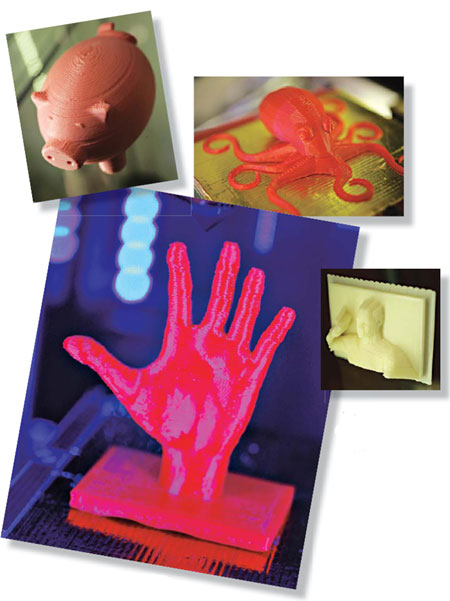Art
Printing in three dimensions
Updated: 2011-06-19 07:46
By Melena Ryzik (New York Times)
|
Plastic objects printed by the relatively affordable, desktop MakerBot 3-D printer can be no more than 12 centimeters on a side. Photographs by Michael Appleton for the New York Times |

"There's nothing like working with plastic!" said Marius Watz, a Norwegian-born artist.
He was describing his experience with MakerBot, a new consumer-grade, desktop-size 3-D printer. With some assembly and do-it-yourself tinkering, the MakerBot makes, or "prints," three-dimensional objects from molten plastic, creating a piggy bank, say, or a Darth Vader head from a computer design.
"I'd heard about 3-D printing in the '90s, but at that time it sounded like some sci-fi technology, like laser guns," Mr. Watz said.
Three-D printing has existed for years, but the machines were cumbersome and expensive, often monopolized by specialists. The MakerBot tops out at about $1,300, giving anybody with a computer and an idea the same creative horsepower, and artists are beginning to take notice.
After a burst of invention by three friends, the MakerBot company was formed in Brooklyn two years ago. Now with 32 employees, it has sold thousands of MakerBot kits.
"It's definitely baked into the DNA of MakerBot that this is a tool for creative people," said Bre Pettis, 38, who worked as a middle school art teacher before starting the company with Zach Hoeken Smith, 28, and Adam Mayer, 35, hardware and Web developers.
MakerBot's founders encourage users to post their designs for the machine on a company blog, Thingiverse.
"We're obsessively open-source," said Mr. Pettis. "In this age of the Internet, the sharers are the people who will come out ahead - the people who make progress and then share it so that other people can stand on their shoulders."
John Abella, a MakerBot hobbyist from Huntington, New York, said the appeal of MakerBot was that "everybody sees it with their own slant."
"My wife's friends look at it, and they ask me for cookie cutters in shapes that don't exist," he continued. "At work people see it and say, 'Can that replace the missing part in the company Ping-Pong table?'" (MakerBot has its limits: it can print objects that are at most 12 centimeters on a side, at a low resolution.)
Noting that nearly 4,500 MakerBots have been sold so far, Mr. Pettis said, "For artists, it's kind of like, imagine, you create something that's a 3-D model, there's 4,500 different locations in the world where it can seep out of the Internet into the real world."
But the ease of replication does present some questions for art professionals. "Art is not traditionally an open-source practice," Mr. Watz, who is represented by the DAM gallery in Berlin, noted dryly. Nonetheless, he posted some of his technical specs on Thingiverse, explaining that he didn't want to take advantage of the generous community spirit there without giving back. And as a digitally oriented artist, Mr. Watz said, he had long questioned the art market's economy of scarcity, even if he participated in it with limited-edition designs.
Some Bot artists are just excited about the machine's practical applications. David Bell and Joe Scarpulla have been laboring for years on a stop-motion animated film with a miniature set. On a whim, Mr. Bell and Mr. Scarpulla bought a MakerBot and found it to be a good fit as a custom manufacturer.
"Our first successful prop was a miniature toilet bowl," Mr. Bell said. Including the design and troubleshooting, using the Bot takes as much time as hand carving, "but the results are definitely better."
Kyle McDonald, MakerBot's current artist in residence, has found that a printer can turn the Kinect, an inexpensive 3-D scanner and Xbox accessory, into a miniature replicator.
"Now I think about physical things," he said. "I spend a lot of time thinking, how can these systems be used in an interactive way?"
The New York Times

Specials

Mom’s the word
Italian expat struggles with learning English and experiences the joys of motherhood again.

Big win
After winning her first major title, Chinese tennis star could be marketing ace for foreign brands

Markers of memories
Axe comes down on historical buildings as part of Harbin government’s baroque programs
